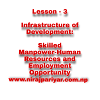Teacher's guide English class 10 Lesson Two Reading
Lesson Two
Reading
Content from textbook
• Vocabulary in use
• Reading comprehension (i& ii )
Required materials
• Flash cards containing the words from „Vocabulary in use (i)‟.
• Contextual meaning of the words underlined in the exercises `
Lesson activities
Vocabulary in use (i)
• Divide the class into groups of 4-6 students each.
• Ask them to work in their groups, and discuss the possible meaning of the words given in
exercise (i).
• Encourage them to refer to the context/sentence in which the words are used in the
debate.
• Ask them to write the meanings in their notebooks.
Suggested answers
- The word „degeneration‟ is not in the text.
Words Meanings
perspective – view, perception
disappear – vanish, disappear
unintelligible – incomprehensible, meaningless
promote – encourage, support
investigate – inspect, examine
Vocabulary in use (ii)
• Organize the class into pairs, and ask each pair to read the given sentences and discuss
the contextual meaning of the underlined words.
• Move around the class while they are discussing. Assist the pair if need be.
• After they finish, ask some of the pairs to give their answers.
Suggested answers
Words Meanings
reluctant – unwilling, hesitant
conference – meeting, session, seminar
barrier – blockade, obstacle, hurdle
fraternity – community, society
flourish – grow, thrive, prosper
lingua franca – common language.
Vocabulary in use (iii)
• Ask the students to look at the given example and underline the synonyms of the given
words. Tell them that the first one has been done for them.
• You can also ask them to make sentences of their own using the given words.
Words Synonyms
determine: fix on; discover; influence
diversity: difference; similarity; variety
inherent: intrinsic; extrinsic, built in
integrity: togetherness; incompleteness; entirety
dialect: standard form; vernacular language; regional variety
reciprocal: interactive; complementary; one-way
Reading comprehension (i)
• Get the students into pairs.
• Tell them to work with their partners to answer the questions.
• Ask them to go through the text, and mark the area that contains the answer of each
question.
• Go around the class and help the pairs answer questions. Pay special attention to the
students who find difficulty.
• Ask them to compare their answers with the immediate pairs.
• Provide feedback. Add ideas, or help students improve their responses.
Suggested answers
a. The two speakers in the debate are Karma and Kabita.
b. Karma is the supporter of fewer languages.
c. Karma claims that using a single language is better for making our life easier and
Kabita claims that using multiple languages is better to make life easier and
comfortable.
d. The Sanskrit language is supposed to have musical quality.
e. Linguistic and cultural differences bring variety in literature.
f. Using single language can minimize communication barrier.
g. Three benefits of having fewer languages are:
It strengthens our fraternity.
It helps in international business and economy.
It promotes integrity and global understanding.
h. The three benefits of having many languages in the world are:
It preserves our identity.
It boosts tourism.
It promotes our culture.
Extended activity
a. Ask the students to make meaningful sentence of their own using each of the
following word/phrase:
a. fix on b. variety c. build in d. one way e. fraternity f. integrity
Reflection
Did the students enjoy the lesson? What problems did I face today? What did I learn from today‟s lesson?





.png)
.png)



.gif)



1 Comments
Nice
ReplyDelete